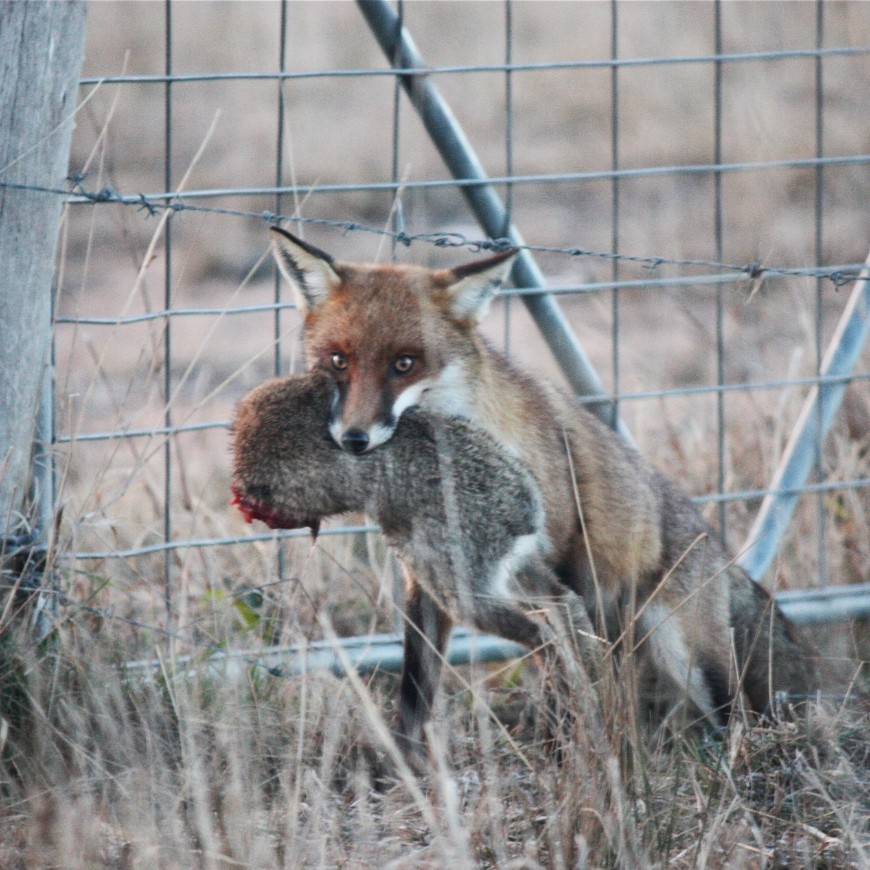Generally, foxes and feral cats eat rabbits. Where there are a lot of rabbits, there it likely to be a lot of foxes and feral cats.
Effective rabbit control, in conjunction with fox or feral cat management, can help to reduce feral cat and fox populations and their impacts by decreasing access to food. This is only effective in areas where rabbits form a primary part of their diet and where other prey species are limited. If there is plenty of other food sources available, such as in high productive landscapes like coastal and temperate environments, reducing rabbit numbers will not impact feral cat and fox populations as alternative prey species are still available.
Rabbit control techniques include baiting, trapping, shooting and warren fumigation and ripping as well as viruses. It is important to use as many techniques as possible, for effective control, rather than just relying on viruses to keep numbers in check.
Where suitable, rabbit control can be important if more direct fox and feral cat control tools are limited. A sudden loss of rabbits can also increase the success of direct control tools as they may become hungrier and may be more likely to take a bait or go into a trap.
When rabbits become unavailable, foxes and feral cats may switch to other available prey, which may cause short-term declines in native species populations. This may be an issue, particularly with threatened species, and small, isolated or breeding populations. Where this is the case, it can be important to manage feral cat and fox impacts alongside reducing rabbit populations. However, research shows that, over the long term, native species often increase after rabbit control that has effectively reduced fox and feral cat numbers.
Controlling rabbit populations also reduces the grazing of native and agricultural vegetation, reduces environmental damage, increases agricultural productivity and provides more shelter for wildlife.

Where abundant, rabbits can form a large part of fox and feral cat diets. Photo: Daniel Schembri.
Advantages
- Rabbit control is an indirect method of control in areas where they are a major food source for foxes and feral cats.
- Effective methods of rabbit control are often available in areas where feral cat and fox management tools might be limited.
- Rabbit control may increase fox and feral cat susceptibility to other control techniques, particularly baiting.
- Rabbit control adds value to a management program by reducing the impact of rabbits on the environment and agriculture.

Rabbits do environmental damage, reduce agricultural productivity and open up the ground to the spread of weeds. Photo: Tanja Strive.
Things to consider when controlling rabbits
- Foxes and cats may switch to another available prey species, reducing the effectiveness of rabbit control in the short term.
- Prey switching after a rabbit decline can impact other species.

Prey switching after rabbit control can negatively impact threatened species like this bilby. Photo: Susan Flashman.
Effective use
The likelihood of foxes or feral cats picking up a bait or going into a trap is greater when they become food stressed. Therefore, undertaking rabbit control before starting a baiting or trapping program can improve the effectiveness of the program. This is only the case in areas where rabbits form a primary part of the feral cat or fox diet and other food sources are limited.
Care must be taken if fox- or cat-susceptible threatened species are present in the program area because this switch could significantly reduce their populations.
Best practice rabbit management uses a range of proven methods in the correct sequence in the right seasonal conditions and should not rely on viruses alone. Key to this is assessing your rabbit population and key areas of infestation; knocking down rabbit numbers with baiting across the whole area; ripping warrens to remove their shelter and access to places to rear young; follow up with further baiting or warren fumigation if needed and finally monitoring rabbit populations into the future.
Environmental monitoring is important to determine the effectiveness of the rabbit control component of a program.

Ripping rabbit warrens is a rabbit control technique, but also reduces the opportunity for foxes to find dens and feral cats shelter. Photo: South Australia Murray–Basin Natural Resources Management.
Useful information
To include rabbit control in your fox or feral cat management program, contact your relevant authority for information on existing projects in your area. For information on best practice management and standard operating procedures for many tools explore:
You must have landholder or land manager permission if undertaking rabbit control on someone else’s property or public land.
Contact your state or territory for more information on regulatory requirements for your program.
Banner photo: Rick Nash.

Some rabbit control techniques such as baiting have training and permit requirements. Check with your local state or territory authority. Photo: Landline.
